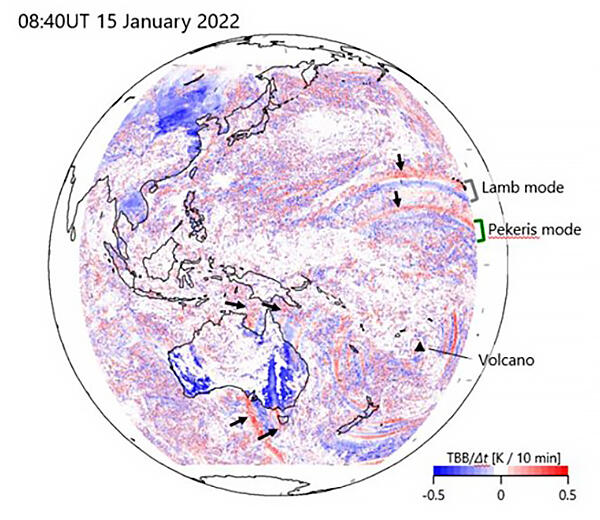A research group led by Deputy Director Shingo Watanabe and Research Fellow Masuo Nakano of the Research Center for Environmental Modeling and Application, Research Institute for Global Change, Japan Agency for Marine-Earth Science and Technology (JAMSTEC), Professor Emeritus Kevin Hamilton of the International Pacific Research Center, University of Hawaii, and Associate Professor Takatoshi Sakazaki from the Graduate School of Science, Kyoto University, has discovered that the January 15 eruption of the Hunga Tonga-Hunga Haʻapai volcano in the South Pacific island nation of Tonga produced a particular type of atmospheric wave (which it proposes calling a "Pekeris" wave) whose existence was uncertain for the past 85 years.
Pekeris waves are a resonant frequency inherent in the Earth's atmosphere, theoretically proposed by Israeli professor C. L. Pekeris in 1937. Whether they exist or not has been a long-standing question in dynamic meteorology.
The study analyzed brightness temperature data observed by the Himawari-8 meteorological satellite during the first 12 hours after the eruption of the volcano and found that, along with Lamb waves moving away from the volcano in concentric circles at the speed of sound (about 315 meters per second), there were also Pekeris waves moving away at about 80% of that speed (about 245 meters per second).

Provided by JAMSTEC
Numerical simulation of the volcanic eruption using a whole, high-resolution neutral atmosphere model reproduced pressure fluctuations with vertical structures consistent with theoretical calculations of Lamb waves and Pekeris waves, respectively. Moreover, these fluctuations spread over the Pacific Ocean at the same speed as the Himawari-8 observations. Furthermore, data from SORATENA barometer arrays captured the horizontal structure of the Lamb and Pekeris waves that crossed Japan and the temporal variation of the barometric pulses, showing that they are consistent with the results of the simulation.
An examination of the vertical structure is also required to confirm whether the Pekeris waves seen in the Himawari-8 data are consistent with the resonance frequencies proposed by Professor Pekeris. Since there is no way to confirm this through observations, a numerical simulation of a volcanic eruption was performed by inputting realistic atmospheric fields into a high-resolution, whole, neutral atmosphere model (commonly known as JAGUAR). The model includes the temperature structures of the troposphere, stratosphere, mesosphere, and lower thermosphere, which are considered necessary conditions for Pekeris waves to resonate in the atmosphere.
As a result, pressure fluctuations with vertical structures consistent with theoretical calculations of Lamb waves and Pekeris waves, respectively, were recreated and spread over the Pacific Ocean at the same speed as those observed using Himawari-8.
Watanabe said, "The tidal fluctuations before the arrival of a typical tsunami may be caused by the mutual interaction of Lamb waves and Pekeris waves with the sea surface. Therefore, the results of this numerical simulation are being input into an ocean model to simulate tidal fluctuations. Hopefully, this will provide valuable insights into the tidal changes caused by atmospheric wave action after volcanic eruptions, helping with disaster mitigation in coastal areas."
This article has been translated by JST with permission from The Science News Ltd.(https://sci-news.co.jp/). Unauthorized reproduction of the article and photographs is prohibited.




